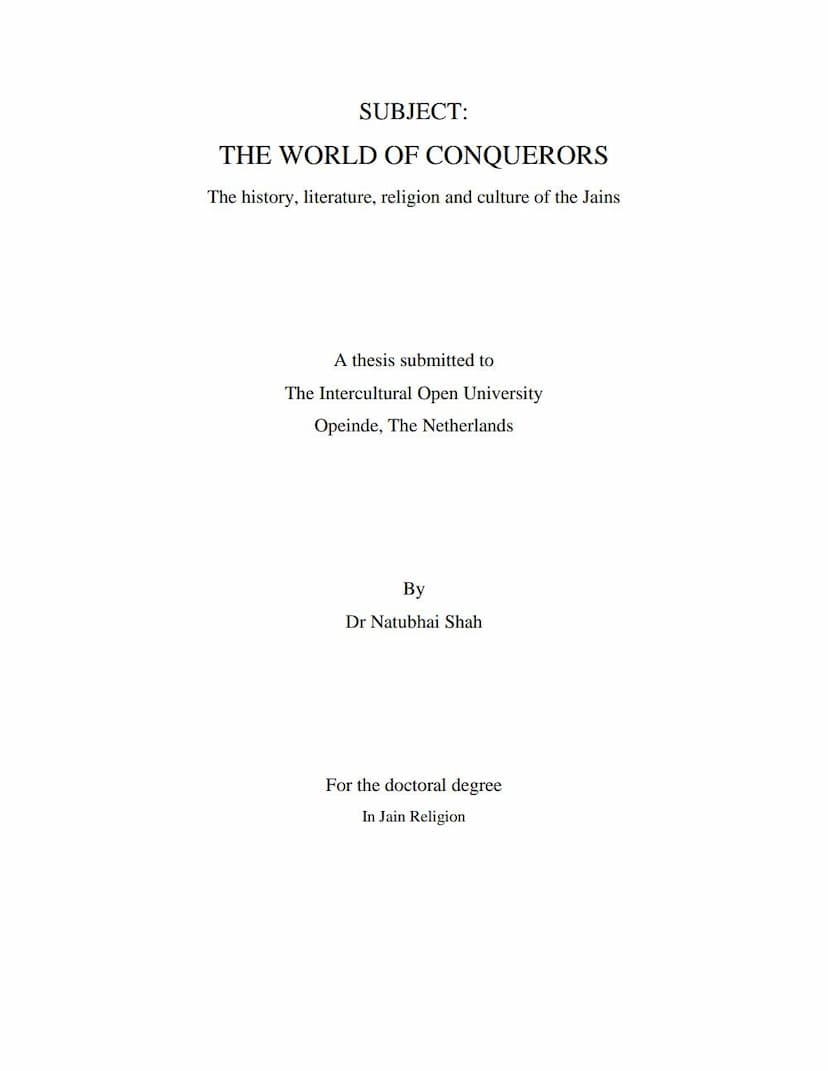World Of Conquerors
Added to library: September 2, 2025

Summary
The book "The World of Conquerors: The History, Literature, Religion and Culture of the Jains" by Dr. Natubhai Shah is a comprehensive exploration of Jainism, a religion originating in India. The author, Dr. Natubhai Shah, has undertaken a significant academic endeavor to present a detailed and accessible overview of Jainism's multifaceted aspects, aiming to bridge the knowledge gap in the West.
The dissertation is structured into several key areas, covering the historical evolution, rich literary tradition, core religious beliefs, and vibrant cultural practices of Jainism. It begins with an introduction to the meaning of life within Jainism and its profound antiquity, tracing its origins back to pre-historic times.
Key aspects discussed in the book include:
- The Meaning of Life: Jainism posits that the ultimate goal of life is self-conquest and spiritual liberation (moksa). This is achieved through the "Three Jewels": Right Faith (samyak-darsana), Right Knowledge (samyak-jnana), and Right Conduct (samyak-caritra). The greeting "Jai Jinendra" itself signifies honor to those who have conquered themselves.
- Antiquity of Jainism: The book delves into the historical evidence, both literary and archaeological, suggesting Jainism is one of the oldest extant religions in Eurasia, possibly predating Vedic traditions.
- The Tirthankaras: Jainism recognizes a lineage of 24 spiritual teachers called Tirthankaras, who guide humanity across the ocean of suffering. The book focuses on the lives and teachings of prominent Tirthankaras like Rishabhdeva (the first), Neminatha (the 22nd), Parsvanatha (the 23rd), and most importantly, Vardhamana Mahavira (the 24th and last Tirthankara of this era). Mahavira is often mistakenly referred to as the "founder" but is revered by Jains as a reviver and systematizer of ancient teachings.
- Core Principles: The fundamental precepts of Jainism are Ahimsaa (non-violence and reverence for all life), Aparigraha (non-attachment to worldly possessions, power, or position), and Anekantavada (multiplicity of views or relative pluralism). Ahimsaa is considered the highest principle, permeating all aspects of Jain life and ethics.
- The Jain Sangha: Mahavira established a fourfold community: monks (saadhus), nuns (saadhvis), laymen (sraavakas), and laywomen (sraavikas). This structure fosters symbiosis, with the laity supporting the ascetics materially and the ascetics guiding the laity spiritually.
- Karma Theory: Jainism presents a detailed and scientific theory of karma, viewing it as subtle material particles that attach to the soul, obscuring its true nature and perpetuating the cycle of birth and death. Liberation is achieved by shedding all karma through rigorous self-discipline, austerities, and adherence to the Three Jewels.
- Jain Logic and Epistemology: The book explores Jain logic, particularly the concepts of Anekantavada (multiplicity of viewpoints) and Syadavaada (relativism or conditional predication), which emphasize understanding reality from multiple perspectives and acknowledging the limitations of human perception and language. This philosophical approach fosters tolerance and intellectual humility.
- Jain Psychology: The text discusses Jain psychology, focusing on the soul (jiva) as the true self, its interaction with matter (ajiva), and the role of mind, passions, and karma in shaping experiences.
- Cosmology: Jain cosmology describes a vast, eternal universe divided into occupied and unoccupied space, with three main worlds: upper (celestial beings), middle (humans, animals, plants), and lower (infernal beings). This detailed cosmological framework provides a context for understanding the soul's journey and the operation of karma.
- Austerities and Yoga: The path of purification involves rigorous austerities (tapas) and meditation (dhyaana) to shed karma and achieve spiritual progress. The book outlines various external and internal austerities, the different stages of spiritual development (gunasthanas), and the practice of Jain yoga.
- Jain Rituals and Practices: The book details the daily rituals (aavasyakas), special festivals like Paryusana and Divali, and life-cycle ceremonies such as initiation (diksaa) and holy death (sallekhanaa). It highlights the distinctions between Svetambar and Digambar practices, the role of the Jain Sangha, and the dedication of both ascetics and laypeople.
- Animal Welfare and Environmental Concerns: Jainism's profound commitment to Ahimsaa extends to all living beings, leading to a strong emphasis on animal welfare and environmental protection. The book discusses the Jain perspective on diet, the ethical implications of various industries, and the inherent respect for all forms of life.
- Vegetarianism and Jain Diet: The book elaborates on the principles of vegetarianism in Jainism, advocating it for spiritual, health, economic, and environmental reasons. It details the prohibited foods and the nutritional balance of a vegetarian diet.
- Jain Community and Social Structure: The book examines the historical spread of Jainism, royal patronage, the emergence of sects (Svetambar and Digambar), and the social organization of the Jain community. It also addresses the challenges and adaptations of the Jain diaspora in the modern world, particularly in Western countries.
- Literature: The book provides an extensive overview of Jain canonical and non-canonical literature, including the Agamas, commentaries, and the vast body of literature produced by prominent ascetic scholars throughout history. It also discusses modern literary trends and translations.
The author's dedication to Aacaarya Vijay Vallabh Surisvarji underscores the vision of integrating empirical and spiritual education for the Jain community. The book aims to be a valuable resource for both scholars and the general reader seeking to understand Jainism, a religion that, despite its antiquity, offers profound and relevant teachings for contemporary challenges.